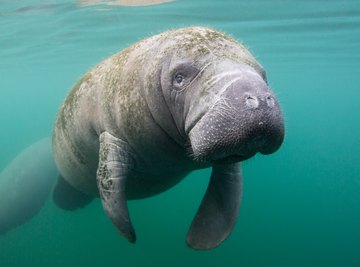
Manatees are also known as sea cows. They are large ocean mammals found on the North American east coast from Massachusetts to Brazil, and in the Gulf of Mexico as far west as Texas. During winter, they migrate to warmer waters. Manatees also inhabit the west coast and rivers of Africa,. Their large size, breathing capabilities, feeding behavior, robust offspring and exceptional hearing are adaptations that help the manatee to survive.
Size and Movement
The large size of manatees provides them good protection against predators. Adult manatees measure 8 to 13 feet and weigh 440 to 1,300 lbs. For such a large mammal, they are capable of high bursts of speed, swimming up to 15 mph. Manatees have developed broad, strong tails that propel them through the water.
Breathing
"Manatees are believed to have evolved from a wading, plant-eating animal," according to the Save the Manatee Club. They have acquired breathing adaptations that enable them to survive in the ocean. When resting underwater, manatees can stay submerged for up to 20 minutes before needing to breath at the surface. A swimming manatee requires more oxygen and may breathe as often as every 30 seconds.
Feeding Behavior
In order to maintain its large size, a manatee can eat from 4 to 9 percent of its body weight each day. Typically, manatees graze for six to eight hours a day. Manatees are primarily herbivorous, feeding on sea grasses and other vegetation. Hind-gut fermentation allows them to efficiently digest cellulose from plants. When vegetation is sparse, manatees occasionally feed on invertebrates and fish.
Offspring
After giving birth, the mother drags the baby to the surface for its first breath. After that, it can swim and breathe on its own. Calves nurse for milk, but can consume vegetation within three weeks after birth, an adaptation that enables maximum growth speed.
Communication
Manatees have exceptional hearing. Communication sounds are produced between mother and calf, as well as between adults. According to Sea World, "The chirps, whistles, or squeaks are probably produced in the larynx. They seem to make these sounds when they are frightened, sexually aroused or interacting with each other."
References
About the Author
Dan Fielder has been writing professionally since 2005. He has written for the "Catskill Mountain Region Guide" magazine in upstate New York and was a copy editor for "The Ojai Bubble." He holds an Associate of Arts from Columbia-Greene College.
